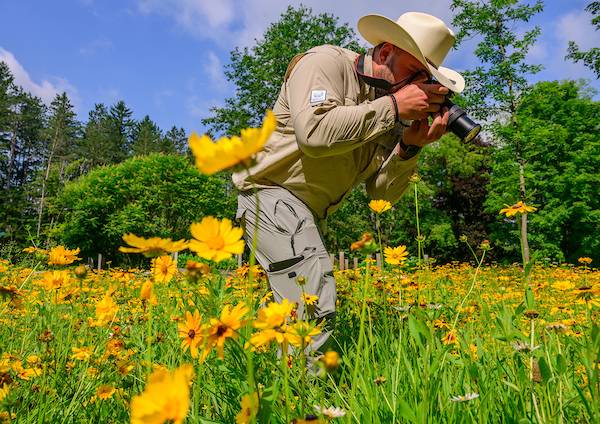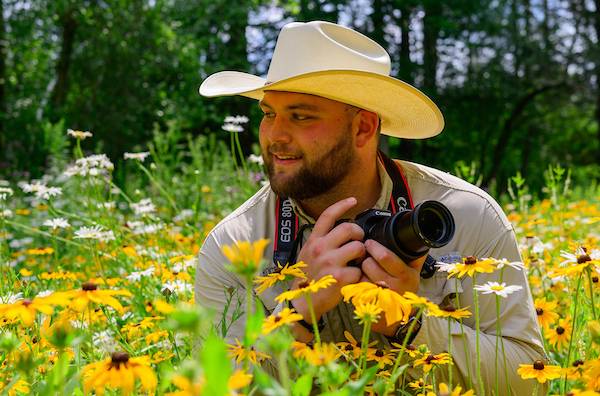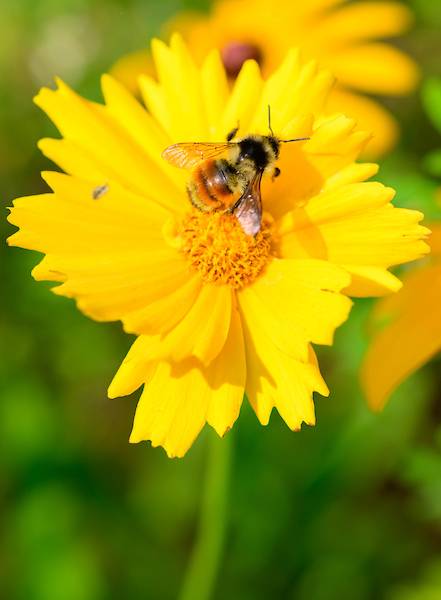Community participation in a new project could play a crucial role in determining the current status of native bee populations in central New York, especially bumble bees.
Matthew McGeary ’24 is one of Upstate Institute’s Summer Field School Fellows working with Rogers Environmental Education Center’s “B-Team” on the project, and is seeking the public’s help to document the status of the area’s native bees. He sees the project as a way to use community science to get people involved in research with real-world stakes.
“It is not too far out of reach that we can’t remedy it,” McGeary says. “It all starts with gathering data on what species are here and moving on from there.”
McGeary has always had a deep love of nature, and he says becoming involved in Rogers’ bumble bee sustainability research gives him a direct opportunity to help preserve the beauty of the local environment.
“Even just in my short 21 years here on Earth, I am already seeing the ways that not only the world’s ecosystems are changing, but also the ones in my backyard,” McGeary says. “I think that last part is crucial, my backyard. Nobody can change the world on their own, but starting on a small scale can still make a big difference.”
The B-Team is heading up Rogers’ Central New York Native Bee Survey, a project that is currently based on the free online app iNaturalist. Anyone who uploads photographs of native bees taken in Cayuga, Chenango, Cortland, Herkimer, Madison, Oneida, Onondaga, Otsego, or Tompkins Counties will be automatically added to the project. To date, Roger’s Media and Marketing Coordinator Jeremy Fetzko says 190 species of bees have been documented in these counties, 14 of which are bumble bees, including the yellow-banded and northern yellow. By knowing which bees are present, what plants they frequent, and which plants need them, conservation action plans can be developed to protect both insects and plants.
Fetzko says mapping these observations will hopefully prove valuable in helping shape conservation practices and legislation in New York State and will help to further Rogers’ efforts to educate people about how they can play a part in maintaining native plants and bees on the landscape.
“By learning more about our native bees and the plants they pollinate, we can make educated choices about the plants we place in our home landscapes, the pesticides we use, how we grow our crops, and where we place honeybee hives so they are not in competition with native bees or spreading disease,” says Fetzko.
Fetzko said this is the first year Rogers has taken on community science initiatives, with the B-Team as the first long-term community science program. The program was initiated by Rogers’ senior educator, Ellen Rathbone, who joined the Friends of Rogers in October 2022. Her interest in bee surveys stems from the work she did in northern Illinois, where the federally endangered rusty-patched bumble bee (Bombus affinis) still has a leghold. Returning to New York, where the rusty-patched once also lived, Fetzko said Rathbone wanted to determine if any still remained locally. So far, statewide surveys have not turned up any rusty-patched bumble bees, but McGeary recently documented another critically endangered species, the Northern amber bumble bee (Bombus borealis) on the property through his survey work. Other rare species, including the yellow-banded bumble bee (B. terricola) and the northern yellow bumble bee (B. fervidus) are still found in New York, and it is hoped that these species will also be documented locally.
The Summer Field School is the Upstate Institute’s signature program, through which students conduct research in partnership with community organizations that use the data to benefit the local area. Rogers has hosted fellows for multiple years. They have assisted with the grants and donor development, and they have been involved in the strategic assessment of the organization’s programming and facilities, providing outside perspectives and expertise on innovations in education and the larger landscape of community assets throughout New York State.
“We hope that this is just the beginning of our partnership and believe that New York as a whole stands to benefit significantly from further collaboration” says Fetzko.


